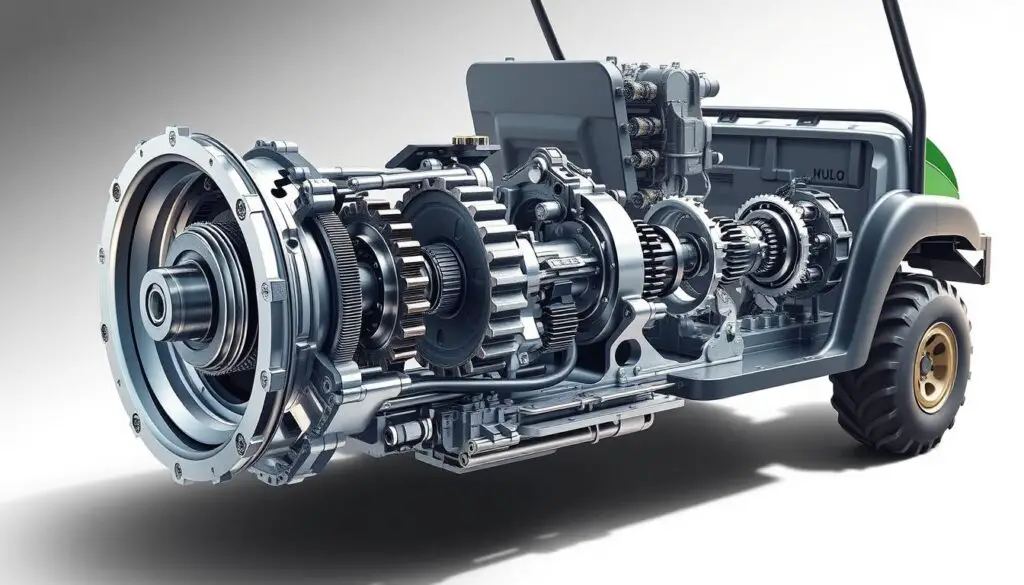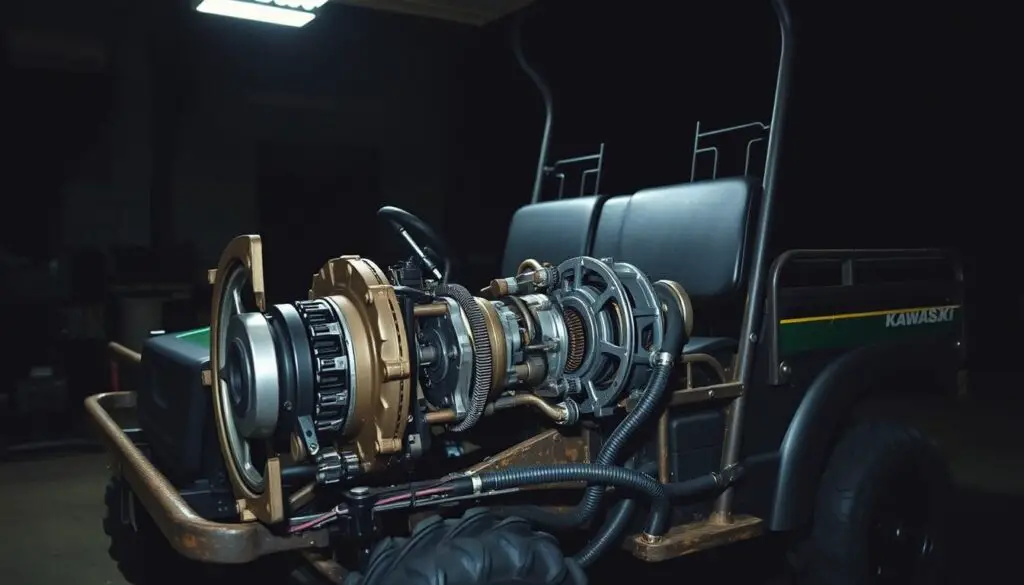The Kawasaki Mule is a versatile utility vehicle used for various tasks, from farming to recreation. However, like any vehicle, it can experience transmission issues that hinder its performance.
Understanding and addressing these issues is crucial to maintaining the vehicle’s reliability and efficiency. This guide provides a comprehensive overview of common transmission problems and offers practical troubleshooting tips to help you identify and fix issues.
Key Takeaways
- Common signs of transmission problems in Kawasaki Mule vehicles
- Step-by-step guide to troubleshooting transmission issues
- Tips for maintaining the health of your Kawasaki Mule’s transmission
- When to seek professional help for transmission repairs
- Preventative measures to avoid future transmission problems
Understanding Kawasaki Mule Transmission Systems
Kawasaki Mule transmission systems vary across models, impacting how the vehicle performs under different conditions. The type of transmission used in a Kawasaki Mule is crucial for its overall functionality and efficiency.
Types of Transmissions in Different Mule Models
The Kawasaki Mule comes with different transmission types, primarily CVT (Continuously Variable Transmission) and manual transmissions. CVT transmissions are more common in modern Mule models, offering smooth and continuous power delivery without the need for manual gear shifting.
CVT vs. Manual Transmissions
CVT transmissions provide ease of use and are suitable for most terrain types, while manual transmissions offer more control, particularly in challenging terrains. The choice between CVT and manual transmissions depends on the user’s specific needs and preferences.
Model-Specific Transmission Features
Different Kawasaki Mule models are equipped with unique transmission features. For instance, some models may have enhanced 4WD capabilities, while others may focus on high-speed performance.
| Model | Transmission Type | Key Features |
|---|---|---|
| Mule 4010 | CVT | Automatic 4WD, high torque |
| Mule 610 | Manual | 6-speed transmission, robust clutch |
How the Kawasaki Mule Transmission Functions
The Kawasaki Mule transmission is designed to transfer power from the engine to the wheels efficiently. Understanding how it works is essential for maintaining and troubleshooting the vehicle.
Power Transfer Mechanism
The power transfer mechanism in Kawasaki Mule transmissions involves a complex system of gears and clutches that work together to deliver power to the wheels.
2WD/4WD Systems
Kawasaki Mule models often come with the option to switch between 2WD and 4WD systems, enhancing traction and control in various terrains.

Kawasaki Mule Transmission Problems
Understanding the common transmission problems in Kawasaki Mules is crucial for maintaining the vehicle’s reliability and performance. Transmission issues can lead to decreased efficiency, increased repair costs, and potentially cause safety hazards. In this section, we will explore the most common transmission problems encountered by Kawasaki Mule owners.
Shifting Difficulties and Gear Slippage
Shifting difficulties and gear slippage are among the most common transmission problems in Kawasaki Mules. These issues can manifest as hard shifting symptoms or gear engagement issues.
Hard Shifting Symptoms
Hard shifting in Kawasaki Mules can be caused by a variety of factors, including low transmission fluid levels, worn clutch components, or misaligned shift mechanisms. Symptoms include:
- Difficulty shifting into gear
- Grinding noises during shifting
- A rough or jerky shifting experience
Gear Engagement Issues
Gear engagement issues occur when the transmission fails to engage gears properly, leading to slippage or the vehicle failing to move. Common causes include:
- Worn or damaged gear components
- Insufficient or contaminated transmission fluid
- Faulty shift linkage or cable
Unusual Noises and Vibrations
Unusual noises and vibrations are indicative of potential transmission problems in Kawasaki Mules. These can include transmission whine or grinding sounds.
Identifying Transmission Whine
A transmission whine is typically a high-pitched noise that occurs during operation. It can be caused by:
- Low or contaminated transmission fluid
- Worn or damaged bearings
- Misaligned or worn gear components
Diagnosing Grinding Sounds
Grinding sounds during shifting or operation can indicate serious transmission problems, such as:
- Worn or damaged clutch components
- Misaligned or damaged gear components
- Insufficient lubrication
Fluid Leaks and Contamination Issues
Fluid leaks and contamination are significant issues that can lead to transmission failure if not addressed promptly.
Common Leak Points
Common areas for fluid leaks include:
- Seal damage or deterioration
- Loose or damaged transmission pans
- Cracked transmission housing
Signs of Fluid Contamination
Signs of contaminated transmission fluid include:
- Dark or dirty fluid
- Presence of debris or metal shavings
- Burnt smell from the fluid

Essential Tools and Materials for Transmission Troubleshooting
Effective transmission troubleshooting for Kawasaki Mule vehicles depends on having the essential tools and materials. To accurately diagnose and repair transmission issues, owners need a combination of basic hand tools, specialized transmission tools, and the right fluids and replacement parts.
Required Diagnostic Tools
Basic hand tools are the foundation of any repair task, including transmission troubleshooting. These include wrenches, sockets, and pliers that are used for various tasks such as removing covers and adjusting components.
Basic Hand Tools
- Socket set
- Wrench set
- Pliers and punches
Specialized Transmission Tools
Specialized tools are necessary for more complex tasks, such as measuring transmission pressure or inspecting internal components.
- Transmission pressure gauge
- Dial indicator
Recommended Fluids and Replacement Parts
Using the correct fluids and replacement parts is crucial for maintaining the health of your Kawasaki Mule’s transmission. This includes choosing between OEM and aftermarket options and ensuring the correct fluid specifications for your model.
OEM vs. Aftermarket Options
OEM parts are designed to meet the manufacturer’s specifications, while aftermarket parts can offer cost savings but may vary in quality.
Fluid Specifications by Model
Different Kawasaki Mule models require specific types of transmission fluid. Refer to your owner’s manual or the manufacturer’s website for the correct specifications.
| Model | Transmission Fluid Type | Capacity |
|---|---|---|
| Kawasaki Mule 3010 | Synthetic ATF | 2.5 quarts |
| Kawasaki Mule 4010 | Conventional ATF | 3.0 quarts |
Diagnosing Kawasaki Mule Transmission Issues
Diagnosing transmission issues in your Kawasaki Mule is crucial for maintaining its performance and longevity. A thorough diagnosis involves several key steps, each providing valuable insights into the health of your vehicle’s transmission system.
Performing a Comprehensive Visual Inspection
A visual inspection is the first step in diagnosing transmission issues. This involves checking external components and linkage for signs of wear or damage.
External Component Check
Inspect the transmission’s external components, such as the housing and mounting brackets, for any signs of damage or wear.
Linkage Inspection
Check the linkage connecting the transmission to the engine and other components for proper alignment and signs of wear.
Checking Transmission Fluid Levels and Quality
Transmission fluid plays a critical role in the smooth operation of your Kawasaki Mule’s transmission. Checking its level and quality is essential.
Proper Fluid Level Testing
Ensure the transmission fluid level is within the recommended range. Low fluid levels can cause significant transmission problems.
Evaluating Fluid Condition
Check the color and consistency of the transmission fluid. Dirty or contaminated fluid can indicate internal transmission issues.
Testing Shift Mechanisms
Testing the shift mechanisms involves checking for smooth gear transitions and identifying any unusual noises or vibrations during shifting.
Evaluating Clutch Performance
Assessing clutch performance is crucial, especially in models with manual transmissions. Look for signs of slipping or dragging.
| Diagnostic Step | Purpose | Indicators of Issues |
|---|---|---|
| Visual Inspection | Identify external damage or wear | Dents, rust, or misalignment |
| Transmission Fluid Check | Ensure proper fluid level and quality | Low fluid level, dirty or contaminated fluid |
| Shift Mechanisms Test | Assess smooth gear transitions | Unusual noises, vibrations, or difficulty shifting |
| Clutch Performance Evaluation | Assess clutch functionality | Slipping, dragging, or unusual noises |
Step-by-Step Repair Solutions
Kawasaki Mule owners can resolve transmission problems efficiently by following detailed repair guides. This section provides a comprehensive overview of the steps required to fix common issues.
Fixing Common Shifting Problems
Shifting difficulties can be frustrating, but they can often be resolved with simple adjustments or repairs. Common issues include worn or misaligned shift cables and damaged shift forks.
Adjusting Shift Cables
To adjust shift cables, start by checking the cable tension. If the cable is too loose or too tight, it can cause shifting problems. Proper adjustment involves tightening or loosening the cable until the desired tension is achieved.
Repairing Shift Forks
Damaged shift forks can cause significant shifting issues. Inspecting the forks for wear or damage and replacing them if necessary is crucial. Precision is key when repairing or replacing shift forks to ensure smooth gear transitions.
Addressing Fluid Leaks
Fluid leaks are another common issue that can lead to transmission problems. Identifying the source of the leak and addressing it promptly is essential.
Replacing Gaskets and Seals
Worn or damaged gaskets and seals can cause fluid leaks. Replacing these components involves removing the old gasket or seal and installing a new one, ensuring a tight seal to prevent future leaks.
Fixing Case Cracks
In some cases, fluid leaks can be caused by cracks in the transmission case. Repairing these cracks requires careful cleaning and sealing of the affected area. Specialized sealants may be needed to ensure a durable repair.
Repairing or Replacing Damaged Components
Damaged components such as bearings and gear sets can significantly impact transmission performance. Identifying and replacing these parts is crucial for maintaining the vehicle’s functionality.
Bearing Replacement
Bearing replacement involves removing the old bearing and installing a new one. This process requires precision and care to ensure that the new bearing is properly seated and aligned.
Gear Set Repairs
Damaged gear sets can be repaired or replaced depending on the extent of the damage. Inspecting the gears for wear or damage and determining the best course of action is essential. Proper alignment of the gears is critical for smooth transmission operation.
When to Seek Professional Help
Identifying the signs that your Kawasaki Mule needs professional transmission repair is crucial for preventing further damage. While some transmission issues can be resolved with DIY fixes, more complex problems require the expertise of a qualified technician.
Signs of Major Transmission Failure
Major transmission failure can be catastrophic for your Kawasaki Mule. Key indicators include severe slipping, inability to shift gears, and loud grinding noises. If you notice any of these symptoms, it’s time to seek professional help. As one Kawasaki technician noted,
“Ignoring these signs can lead to costly repairs down the line.”
Finding a Qualified Kawasaki Mule Technician
To find a qualified technician, look for certifications and experience with Kawasaki Mule models. Check online reviews and ask for referrals from other Kawasaki owners. A reputable technician will diagnose the issue accurately and provide a detailed estimate for the repairs.
Estimated Costs for Professional Repairs
The cost of professional repairs varies widely depending on the nature of the problem and the technician’s rates. On average, you can expect to pay between $500 to $2,000 for transmission repairs. It’s essential to get a detailed estimate before authorizing any work.
Conclusion
Effective troubleshooting and maintenance of the Kawasaki Mule transmission are critical to ensuring the vehicle’s optimal performance and extending its lifespan. By understanding the transmission system, identifying common issues, and applying the appropriate repair solutions, owners can address problems efficiently.
Regular checks and maintenance, as outlined in this Kawasaki Mule transmission troubleshooting guide, can help prevent major transmission failures, reducing the need for costly repairs. Whether you’re a seasoned Kawasaki Mule owner or new to the world of utility vehicles, this guide has provided valuable insights into maintaining your vehicle’s transmission.
By following the steps and recommendations outlined, you’re now better equipped to diagnose and address transmission issues, ensuring your Kawasaki Mule remains in top condition.
FAQ
What are the most common transmission problems in Kawasaki Mule vehicles?
Common issues include shifting difficulties, gear slippage, unusual noises, vibrations, fluid leaks, and contamination problems.
How do I diagnose transmission issues in my Kawasaki Mule?
Start with a comprehensive visual inspection, check transmission fluid levels and quality, test shift mechanisms, and evaluate clutch performance.
What tools are required for Kawasaki Mule transmission troubleshooting?
Essential tools include basic hand tools, such as wrenches and pliers, and specialized transmission tools, like bearing pullers and gear installers.
Can I use aftermarket transmission parts for my Kawasaki Mule?
While OEM parts are recommended, aftermarket options can be used if they meet the manufacturer’s specifications and are compatible with your Mule model.
How do I know when to seek professional help for my Kawasaki Mule transmission issues?
Look for signs of major transmission failure, such as severe gear damage or significant fluid leaks, and consider seeking help if you’re unsure about the diagnosis or repair.
What are the estimated costs for professional Kawasaki Mule transmission repairs?
Costs vary depending on the type of repair, labor rates, and parts required, but expect to pay between 0 to
FAQ
What are the most common transmission problems in Kawasaki Mule vehicles?
Common issues include shifting difficulties, gear slippage, unusual noises, vibrations, fluid leaks, and contamination problems.
How do I diagnose transmission issues in my Kawasaki Mule?
Start with a comprehensive visual inspection, check transmission fluid levels and quality, test shift mechanisms, and evaluate clutch performance.
What tools are required for Kawasaki Mule transmission troubleshooting?
Essential tools include basic hand tools, such as wrenches and pliers, and specialized transmission tools, like bearing pullers and gear installers.
Can I use aftermarket transmission parts for my Kawasaki Mule?
While OEM parts are recommended, aftermarket options can be used if they meet the manufacturer’s specifications and are compatible with your Mule model.
How do I know when to seek professional help for my Kawasaki Mule transmission issues?
Look for signs of major transmission failure, such as severe gear damage or significant fluid leaks, and consider seeking help if you’re unsure about the diagnosis or repair.
What are the estimated costs for professional Kawasaki Mule transmission repairs?
Costs vary depending on the type of repair, labor rates, and parts required, but expect to pay between $200 to $1,000 or more for complex repairs.
How often should I check the transmission fluid in my Kawasaki Mule?
Check the transmission fluid level regularly, ideally every time you use your Mule, and change it according to the manufacturer’s recommended maintenance schedule.
Can I repair my Kawasaki Mule transmission myself?
Yes, many repairs can be done DIY, but it’s essential to have the right tools, knowledge, and experience to avoid causing further damage.
,000 or more for complex repairs.
How often should I check the transmission fluid in my Kawasaki Mule?
Check the transmission fluid level regularly, ideally every time you use your Mule, and change it according to the manufacturer’s recommended maintenance schedule.
Can I repair my Kawasaki Mule transmission myself?
Yes, many repairs can be done DIY, but it’s essential to have the right tools, knowledge, and experience to avoid causing further damage.


